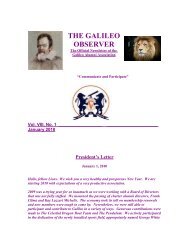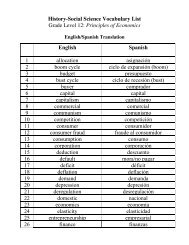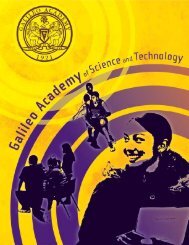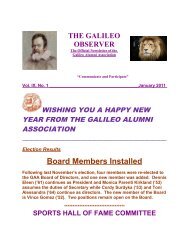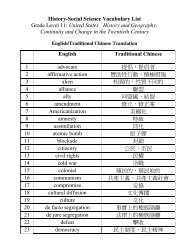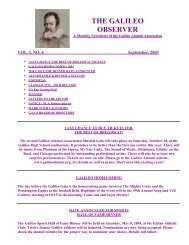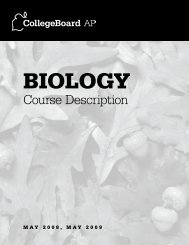THE GALILEO OBSERVER - March, 2004 - Galileo Academy
THE GALILEO OBSERVER - March, 2004 - Galileo Academy
THE GALILEO OBSERVER - March, 2004 - Galileo Academy
Create successful ePaper yourself
Turn your PDF publications into a flip-book with our unique Google optimized e-Paper software.
Major Nourse believed in the value of shop training and it paid off well for him. One summer hejourneyed down into the Central Valley. While there he called upon a certain young lady whom hethought was a little bit nicer than any other young lady he had met. During his visit the young lady'sfather was having trouble with an old fashioned clock. The father asked Joseph if he could fix theclock. Joseph fixed the clock, but went back home without the young lady. The following summer hevisited the young lady and her father was most enthusiastic that the clock had kept perfect time allyear. This time Joseph returned home with the young lady, who became his life long wife. MajorNourse encouraged all male students to take advantage of the shop classes.Major Nourse resided in San Francisco on Arquello Boulevard. While he was Principal of <strong>Galileo</strong>High School, he lost both of his parents. His mother passed away at the age of 73 on November 4,1928. His father lived until February 14, 1933 and was 88 when he died. Major Nourse's fatherfrequently came to <strong>Galileo</strong> High School to share his Civil War escapades with the students. He metPresident Lincoln shortly after the Civil War began in 1861.On <strong>March</strong> 22, 1933, Major Nouse joined the "Royal Order of Grandparents," with the birth of his firstgrandchild, Robert Sylvester Nourse. In October 1924, Principal Nourse had the honor of hosting agroup of visiting school superintendents who were in San Francisco for a conference.On November 13, 1924, the <strong>Galileo</strong> Faculty hosted the 4th annual Birthday Party for Major Nourse.The faculty planned the party and the highlight was "sentencing" the principal to spend the rest ofhis life at <strong>Galileo</strong> High School. Major Nourse sat at the head of the table behind a large cake with thecandles burning brightly. In front of 60 faculty members, just after he was sentenced to eternal life at<strong>Galileo</strong>, he replied, "I hope that when you become, in the words of a newspaper article recently, a'little grayed-haired man with a one-sided smile' you will have such friends about you as I havenow." Toasts during the evening praised Nourse's great qualities of leadership, great abilities, willand generosity.Major Nourse was said to know all of the students after the first several months of school. Headmired the brilliant students and befriended the boy or girl who may not be doing so well. He knewthe accomplishments and failures of each of his 1100 students. He understood young people andtheir problems and gained the admiration and respect of the students. He was said to remember thebest in everyone and forget all else.Darrell Dounell, a noted radio commentator in San Francisco described Nourse as "the man whoreaches for the stars but keeps his feet on the ground. Students were heard to say, "What will we dowithout Major Nourse?" One of his chief characteristics was that of modesty.On May 12, 1936, Major Nourse was appointed Superintendent of Schools in San Francisco after 16years as Principal of <strong>Galileo</strong> High School.Ed. Note: I am indebted to Bettie Grinnell at <strong>Galileo</strong> <strong>Academy</strong> for providing us with this history ofMajor Nourse. Her tireless efforts to research and prepare this biography are greatly appreciated.Bettie will be writing the histories of all the Principals, and we will publish them in each issue of TheObserver. The story of Major Nourse is an inspiration to all high school Principals. It is a gift for all<strong>Galileo</strong> students, faculty and alumni. Nourse Auditorium on Van Ness Avenue was named afterMajor Nourse. It is now the home of the San Francisco Unified School District offices.How to be a San Francisco NativeIf you have spent any time in bookstores lately, you must have noticed that there are books on SanFrancisco's past, present and future; books that tell you where to eat, where to drink, where to drive, where totake a bus where to stay, what to look at and even how to cook in the San Francisco style, whatever that is.But no book tells you how to act like a native San Franciscan, because it is widely assumed that the breed, if itever existed, is extinct.
One book, "San Francisco Free and Easy," subtitled "The Native's Guide Book," says on the first page, "SanFranciscans are notorious newcomers. You'll find few people here with the sort of roots common to EastCoast cities?" Another, written by a carpetbagger named John K. Bailey, is called "The San FranciscoInsider's Guide." It begins, "On my first visit to San Francisco, 15 years ago?" Fifteen years ago? I know a catwho's lived here longer than that!A terrible thing has happened to native San Franciscans. They have become strangers in their own city. Theirwhole culture is in danger of being swallowed up by foreigners from New York, Ohio, New Hampshire, Denver,and other places Back East. These newcomers all assume everyone else is a newcomer. The first thing to gois the language. Despite everything you've ever heard, there is a distinctive San Francisco way of talking and itis important to make note of it, for the record, before it becomes as dead as Latin.Here's how to talk like a San Franciscan. The first lesson - learned at birth - is never to call it Frisco or SanFRANcisco. Most resident tourists have settled on something that sounds like an Anglicized version of theSpanish San Francisco, but natives run the two words together and add a couple of extra sounds, and itcomes out "Sampencisco." It may also be called thecity, which is one word. It is never called The City, whichis two words and tacky.One way to tell San Franciscans is the way they run words together. Another way is that all native SanFranciscans know something about other native San Franciscans. This cannot be faked. The first test comeswhen a native San Franciscan is introduced to someone he does not know at a party. Sooner or later, one willask the other where he or she is from. The correct dialogue goes like this:Q: Whereya from?A: Here.Q: Oh yeah? Whereja go to school?A: Poly.Q: Oh yeah? Doya know (fill in name of acquaintance)?At once, the two people realize they are both natives and doubtless have friends, experiences, and a wholesubculture in common.There are several keys to this small bit of conversation. First, the true native runs all the words together. Henever says, "Where are you from?" because that is the way they talk Back East. When he asks where you wentto school, he means high school - not college, not trade school, and certainly not P.S. 178. The correct answeris one of several San Francisco high schools. "Poly," of course, means Polytechnic High School, which notonly reveals your high school but what district of the city you came from, and other details.. If, for example,the answer is "S.I." you know the man went to St.. Ignatius High and was probably raised a Catholic and isfrom an upper-middle-class family. SH people were from North Beach and the Mission, better known asSacred Heart. If the person says "Mission" or "Bal" (for Balboa High) you know he is from the Mission District,and his father was probably a member of the working class, called "a workin man" in the San Franciscodialect. If he went to Lowell, he may well be Jewish; if he went to <strong>Galileo</strong>, he is probably a North Beach Italian,and not a Mission District Italian. One has to be careful, though. Some women, asked where they went toschool, will respond that they "went to the madams." A tourist will immediately leap to the conclusion that thepoor woman was raised in a whorehouse, but natives understand immediately what this woman means: Sheattended the Convent of the Sacred Heard, conducted by a ritzy order of nuns, and is doubtless from a wealthyfamily. She is not necessarily a Catholic, however. Diane Feinstein went to the madams.The next thing to note about this conversation is that the proper response to a remark is "Yeah?" not "Youdon't say so?" or "Is that right?" San Franciscans say "yeah" a lot, but it doesn't always mean yes.Now you are ready for your geography lesson. Oakland, Berkeley, and all those other places are "across theBay." The largest city in Santa Clara County is "Sannazay," not "San Jose." Sannazay is near Sannacruise. Toget there, you have to go Down the Peninsula, past South City, Sammateo, Rewoodcity and a whole bunchaother towns.The River is the Russian River, and no other, but the Lake is Lake Tahoe only if your family was wealthy;otherwise, the lake is Clear Lake. The Mountain is Tamalpais; Mount Diablo is "Dyeaablo," and is has no firstname. The town on the river is called Gurneyville, even though the correct pronunciation is Gurnville. SanFranciscans know the correct pronunciation but choose not to use it. If corrected on this, a native will likelysay, "If those guys up there are so smart, what'er they doin' livin' there? People who live in Gurneyville all
Do the word “prunes” have a bad connotation? I bought a bag of Pitted Dried Plums at Costcorecently. That’s like buying a box of Seedless Dried Grapes (otherwise known as raisins). . .Helen Wills Playground where many of us played as kids before and during attendance at <strong>Galileo</strong> isundergoing a complete renovation. If you go by the corner of Broadway and Larkin, you’ll see avirtual empty lot. . .That was a mighty honorable gesture on the part of the Oakland A’s baseball team to contribute theproceeds of three games to the Contra Costa County School District for their sports program. Now ifonly the Giants management. . .Did you know that if you are smelling various perfumes or colognes and do not want mix them up,smelling ground coffee will solve the problem. . .Barry Levinson’s book, “The Seventh Game of the World Series”, says that the Giants played in 4 ofthe 35 games over the years and lost every one. . .Understand the recent Mustard Festival in Napa Valley was a huge success. I am allergic to mustardand horseradish and didn’t attend. I am getting sick just writing about it. . .The town of Yountville must be the per capita gourmet capital of the world. There are at least eightworld class restaurants within a few blocks of each other: Bistro Jeanty, Pere Jeanty, The FrenchLaundry (will reopen shortly), Bouchon, Hurley’s, Domaine Chandon, California Café, Compadres(definitely not world class!), and the defunct Diner (maybe it’ll open soon, we hope). . .Did you know the Lion is the symbol of Venice, Italy?Renee Mau Wade (Class of 1951) recently moved back to the Bay Area after living in Las Vegas.Welcome back, Renee!Calling all alumni, calling all alumni! Where is Jim Hobbes? Anybody know? Email us:Editorgalileoobserver@yahoo.com. . .Saw a great interview with Barbra Streisand on Bravo’s Inside the Actor’s Studio, where she was morecandid and revealing than in the Barbara Walters interview. It must be Host James Lipton’s chairsidemanner. . .When we were kids, my brother used to scare me by pretending he was Frankenstein and flashing thebedroom light on and off while walking into the room with outstretched arms. Now the Bushman haswon his case in court and is back on the steet. He is the fellow who hides behind two large branchesat Fisherman’s Wharf and surprises unsuspecting tourists by jumping out at them. Sounds likesomething we would do as kids. . .Phil Pallette (Class of 1934!) has written a biography of “Hank” Luisetti, the great <strong>Galileo</strong> andStanford basketball player, and it is in the editing stages (See Letters). . .MUNIficent! Read in the EX that MUNI has added a stop to its #28 line to accommodate <strong>Galileo</strong>students. Now they can step outside the school door and board the bus bound for the SunsetDistrict. What a change from the 50s when most us attended the high school closest to our home.Saw the obit for Dennis J. Doolin (Class of 1951) in the Ex. At <strong>Galileo</strong> Dennis was a good student andheld the top rank in ROTC and was a member of the Science Club. He later went to USF andStanford, where he earned an M.A. and PhD. A veteran of the Korean War, Dennis lived in Japan for25 years. In his career with the U. S. government, he served as Defense Dept. Senior China Analyst,as Deputy Assistant Secretary of Defense for East Asia, and as Deputy Undersecretary of the Air Force
for International Affairs. He left many relatives and friends. The funeral was held February 18 th inTokyo, and he was buried at Holy Cross Cemetary in Colma. Dennis was 70 years old. . .Another sad note: Francisco Casey “Sonny” Pacheco (Class of 1951) has passed away. Casey, as hewas known, played lightweight basketball at <strong>Galileo</strong>. Most recently he had a moving business calledCasey’s Office Moving and Storage. . .Spring Valley Science Magnet Elementary School, where many of us <strong>Galileo</strong> alumni went, recentlyreceived the highest possible score of 10 in the Academic Performance Index when compared tosimilar schools throughout California. Other elementary schools receiving a perfect 10 were JohnYehal Chin, Garfield, George Moscone, George Peabody, and Sherman. . .When driving, have you stopped to think how often you do not think to stop?We Need New BloodWe notice that most of the news in this newsletter and the membership ofGAA consist of alumni who graduated in the 1950s. <strong>Galileo</strong> has a 80 yearhistory, yet most of the alumni, except for those holding reunions, whoparticipate in the alumni association are from a very few years. We needmore people from before the 50s and after the 50s. All those who areplanning reunions should encourage and offer membership in GAA. As oneclass did, they can offer a year’s membership as part of the reunion fee.That way GAA would have wider representation.This is an opportunity for recent graduates to keep their ties to <strong>Galileo</strong>and for older grads to renew their ties and re-discover and relive highschool memories and share them with classmates.There is a membership form at the end of this newsletter and also on the<strong>Galileo</strong> website, www.galileoalumni.org. Please fill it out and send itin. Give something back to the school that gave you your high schooleducation. For less than the cost of a glass of wine, you can be a memberof the <strong>Galileo</strong> Alumni Association. Join today!Magic Show – April 3.Annual Spring Festival –May 7.Sports Hall of Fame Dinner – May 8.*Calendar of Upcoming EventsLetters to the EditorIn seeing the list of <strong>Galileo</strong> Principals in the February edition brought back some happy memories. When I went to<strong>Galileo</strong>, Dr. Morena was the Principal and James Kearney (don’t say Hey Mr. Kearney) was my favorite teacher.Mr. Kearney was my World History teacher, and a friend of mine in the class had a major crush on him (we neverrealized how young he was at the time). After Mr. Kearney left <strong>Galileo</strong> he became the principal of Wallenberg HighSchool. He has since passed away. Oh, those were the days. –Kathy George Guerrero (Class of 1960)
* * * * *I am working to get the book [on “Hank Luisetti] edited right now. All in my sleep-deprived spare time. Had aminor physical breakdown last week, but am back at it now. I have about fifty photos. I want to thank you againfor your background information on Tom DeNike. I always wondered about a history teacher who left <strong>Galileo</strong>before your time: Gladys Lorigan. She went to Lowell in 1946 to become Dean of Girls, but she had been one ofthe most involved faculty members at <strong>Galileo</strong> from 1929 on until she left. A good majority of the boys had crusheson her as she was a beautiful woman in the class of a Grace Kelly. I received several responses about her from both<strong>Galileo</strong> guys and guys and girls from Lowell. –Phil Pallette (Class of 1934)* * * * *You brought up Don Pitts (Song: Don Pitts On The Air). Well, now I remember that I was a guest on his show forsome reason. I think I introduced a disc or two. Also a group of us from The Pendulum used to go to Bimbo’s tointerview the featured singer. Tony Martin’s interview, I recall, made The Pendulum. Our Editor was Bobbie (Ican’t think of her last name right now but she was smart and good looking) and, as I heard, went on to write novels.Beverly Hislop and Al Mazzucco were also along for the ride although I don’t know why as they weren’t on thestaff. Thanks for reminding me of some good experiences. –Bill Dito (Class of 1950)Ed. Note: Bobbie’s name was Barbara McElroy who preceded me as Editor of The Pendulum in 1949. DonPitts had a program on radio station KYA. Bill Dito is an avid movie and music fan, has composed musicals,and lives in the Marina. He married Barbara Dito, a cousin and <strong>Galileo</strong> classmate, who has since passed away.Bill is a good friend and neighbor of Bob Fouts, former 49ers broadcaster and father of Hall of FameQuarterback Dan Fouts.President: Jim Dresser (1951)Vice President: Joe Scafidi (1950)Secretary: Monica Parenti Kirkland (1953)Treasurer: Augie Venezia (1953)DirectorsMel Chiarenza (1953)Frank Clima (1951)Nina Pattini Clima (1950)Diane Wall Cowart (1965)Sisvan Der Harootunian (1951)Kay Lazzari Michelis (1953)Fred Setting (1950)Cordy Porter Surdyka (1953)Janet Sullivan Neilsen (1953)Bernard Valdez (1949)GAA BOARD OF DIRECTORSCommittee ChairpersonsPublic Relations: Cordy Porter Surdyka (1953)Membership: Diane Wall Cowart (1965)Database: Mel Chiarenza (1953)By-laws: Monica Parenti Kirkland (1953)Communications (Newsletter): Sisvan Der Harootunian (1951)Webmaster: Vaughn Spurlin (1960)FOR <strong>THE</strong> LATEST INFORMATION, VISIT <strong>THE</strong> <strong>GALILEO</strong> ALUMNI ASSOCIATION WEBSITE,WWW.<strong>GALILEO</strong>ALUMNI.ORG.
The <strong>Galileo</strong> Observer is a monthly publication of the <strong>Galileo</strong> Alumni Association, 1150 Francisco Street, San Francisco, CA 94109. Views expressed are strictly thoseof the Association and in no way reflect those of the <strong>Galileo</strong> <strong>Academy</strong> of Science and Technology, its students or faculty. James Dresser, President; Sisvan DerHarootunian, Editor; Vaughn Spurlin, Production Manager/Website Director. Copyright <strong>2004</strong>, <strong>Galileo</strong> Alumni Association.Comments? Contact the <strong>Galileo</strong> Alumni webmasterlast updated 01april<strong>2004</strong>© 2002, 2003, <strong>2004</strong> <strong>Galileo</strong> <strong>Academy</strong> of Science and Technology Alumni Association of San Francisco



